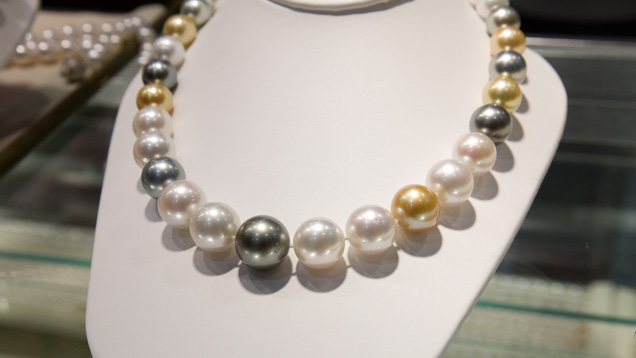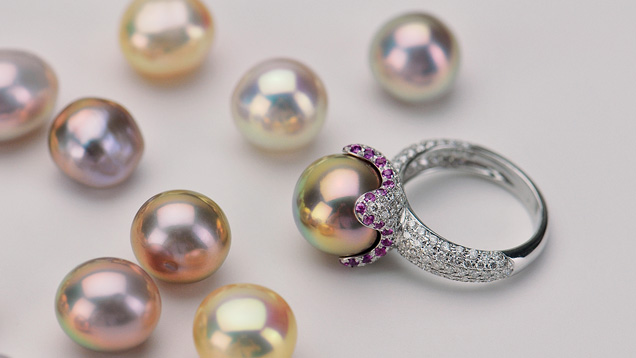Different types of pearls
For centuries, pearls have been a symbol of beauty and purity. The most familiar colors are white and cream (a light yellowish brown). Black, gray, and silver are also fairly common, but the palette of pearl colors extends to every hue. The main color, or bodycolor, is often modified by additional colors called overtones, which are typically pink (sometimes called rosé), green, purple, or blue.
Pearls, natural or cultured, are formed when a mollusk produces layers of nacre (pronounced NAY-kur) around some type of irritant inside its shell. In natural pearls, the irritant may be another organism from the water. In cultured pearls, a mother-of-pearl bead or a piece of tissue is inserted (by man) into the mollusk to start the process.
For both, the quality of the nacre dictates the quality of the luster, or shine of the pearl, which is very important to its beauty and its value. The surface of the pearl should be smooth and free of marks while the overall shape could be round, oval, pear-shaped, or even misshapen. Misshapen pearls are called baroque pearls.
While shopping for pearls, there are various lengths available:
- A collar fits directly against the throat
- A choker rests at the base of the neck
- The princess length reaches near the collarbone
- A matinee length is usually 20-24 inches
- The Opera length is 30-36 inches
- The longest length, known as a rope, refers to all strands longer than 36 inches
Cultured pearls are popular for bead necklaces and bracelets, or mounted in solitaires, pairs, or clusters for use in earrings, rings, and pendants. Larger pearls with unusual shapes are popular with creative jewelry designers.
Pearl—natural or cultured—is a US birthstone for June, together with alexandrite and moonstone.
NATURAL PEARLS VS. CULTURED PEARLS
Natural Pearls
Natural pearls form in the bodies, or mantle tissue, of certain mollusks, usually around a microscopic irritant, and always without human help of any kind.
Cultured Pearls
The growth of cultured pearls requires human intervention and care. Today, most of the mollusks used in the culturing process are raised specifically for that purpose, although some wild mollusks are still collected and used.

PEARL TYPES
There are four major types of cultured whole pearls:
Akoya Cultured Pearls
Akoya cultured pearls are the most familiar type of saltwater cultured pearl to most people in the U.S and other western markets. Many customers think of white or cream colored akoyas as the classic pearl used for jewelry, especially single-strand necklaces. Japan and China both produce akoya cultured pearls.
South Sea Cultured Pearls
Australia, Indonesia, and the Philippines are leading sources of these saltwater cultured pearls. South Sea cultured pearls can be white to silver or golden, depending on the type of oyster. Their large size and thick nacre, due to a long growth period, plus their limited critical growing conditions are all factors contributing to their value.
Tahitian Cultured Pearls
Cultivated primarily around the islands of French Polynesia (the most familiar of these is Tahiti). These saltwater cultured pearls, sometimes referred to as black pearls, have a wide color range. They might be gray, black or brown, and they can have blue, green, purple or pink overtones.
Freshwater Cultured Pearls
Freshwater cultured pearls are the most commonly produced pearls and they are one of the most popular pearl types among shoppers and jewelry designers. This is due to their remarkable range of sizes, shapes and colors, plus their commercial availability at lower price points. They are usually cultured in freshwater lakes and ponds, often with many pearls grown in one oyster. China is the leading source for freshwater cultured pearls. Many freshwater pearls don’t have a bead nucleus — only a piece of tissue — resulting in a pearl with thicker nacre than the akoya.
PEARL TYPES
There are four major types of cultured whole pearls:
Akoya Cultured Pearls
Akoya cultured pearls are the most familiar type of saltwater cultured pearl to most people in the U.S and other western markets. Many customers think of white or cream colored akoyas as the classic pearl used for jewelry, especially single-strand necklaces. Japan and China both produce akoya cultured pearls.
South Sea Cultured Pearls
Australia, Indonesia, and the Philippines are leading sources of these saltwater cultured pearls. South Sea cultured pearls can be white to silver or golden, depending on the type of oyster. Their large size and thick nacre, due to a long growth period, plus their limited critical growing conditions are all factors contributing to their value.
Tahitian Cultured Pearls
Cultivated primarily around the islands of French Polynesia (the most familiar of these is Tahiti). These saltwater cultured pearls, sometimes referred to as black pearls, have a wide color range. They might be gray, black or brown, and they can have blue, green, purple or pink overtones.
Freshwater Cultured Pearls
Freshwater cultured pearls are the most commonly produced pearls and they are one of the most popular pearl types among shoppers and jewelry designers. This is due to their remarkable range of sizes, shapes and colors, plus their commercial availability at lower price points. They are usually cultured in freshwater lakes and ponds, often with many pearls grown in one oyster. China is the leading source for freshwater cultured pearls.

Different types of pearl producing species (first two columns), trade names of their pearls (third column) and characteristic color nuances of the pearls (last column). The pearls produced by the species of the first four rows are true pearls as they consist mainly of aragonite layers. The pearl produced by the Melo melo sea snail (last column) consist mainly of calcite prisms and is hence a non-nacreous pearl. Image properties: Gemological Institute of America.

Imitation pearls
Imitation pearls are usually a coated glass bead. Most have a high luster, but not the depth of luster seen on high quality cultured pearls.
It's possible to separate an imitation from a cultured or natural pearl. It can be a challenge, though, to determine if the pearl is cultured or natural. And, many pearls undergo treatments to either enhance their luster or alter their color.


































































